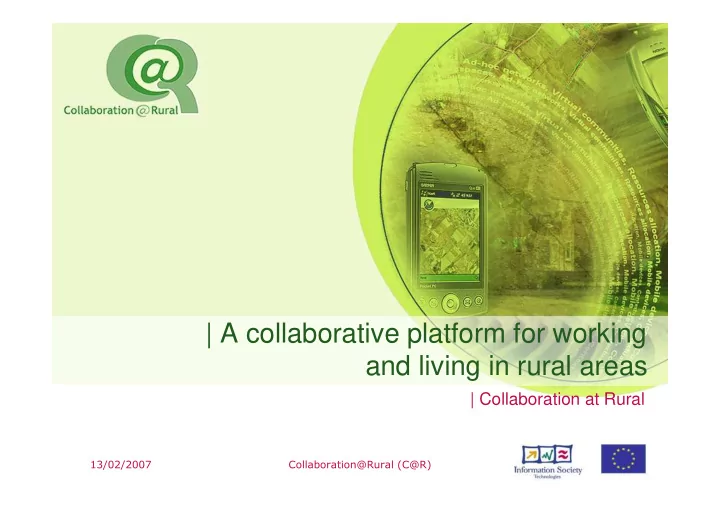

| A collaborative platform for working and living in rural areas | Collaboration at Rural ���������� �������������������������
C@R - Presentation Summary • Overall Project Objectives • Project Organisation • Architecture and Service Goals • Living Labs Vision • Conclusions � �������������������������
C@R - Overall Objectives • C@R intends to promote collaborative working environments • key enablers of sustainable development in rural areas • C@R proposes a technological response to the barriers preventing rural development • development, test and validation of a collaborative platform to enhance the capabilities of rural inhabitants leading to a better quality of life and a revalorization of rural settings • C@R uses the living labs methodology as a way to involve rural constituency in RTD activities taking advantage of collaborative technologies • inclusion in the wide sense : to enable people in remote and rural Europe to fully participate in the knowledge society as citizens and professionals � �������������������������
C@R expected impact �������������������� � ������������������������������������������������ � ����������������������� @Work Will foster rural sustainable ������������������� development � ���������������������������!�� � ����������������������������"��������#������������� � ������������������������� ����������������������������������������� � ����������������������������������������� � ������������������������������� ����� ���������������������� ���������������������������� � ����������������������������������� � ���������������������������� �������������������������� � �������������������������
C@R – Partners and figures • Partners • Project Coordinator – TRAGSATEC • Executive Management Board Chair - ESA • 29 partners • 12 European and 2 INCO countries • Key Service Industry, Value Added and SME • International institutions, and Key National Users • Research, University • Project Figures • Total cost: about 15 M€ • Funding: 8.65 M€ • Duration: 36 months � �������������������������
C@R – Partners types International Industry organisations and end-users partners SMEs Academia - Research
C@R Project RTD Lines C@R development in 4 RTD activity blocks • Collaborative Architecture / Framework • Collaborative Core Services Open Collaborative • Software Collaborative Tools Platform • 4 coordinated Living Labs in innovative and traditional sectors distributed in Europe and elsewhere (7 sites) • Collaborative Rural Incubator • Collaborative Open Communities / Governance • Collaborative Fishery • Systemic and sustainable use of results in C@R • Socio-economical impact on policies for rural development • Assessment, dissemination, exploitation … � �������������������������
C@R layered reference model VA6 User domain VA3 VA5 VA4 VA1 VA2 RLL CWE platform domain SCT Enabling components domain CCS � �������������������������
CCS and CTS services • CCS basic component • Communication resources , e.g. network access systems, advanced routing techniques… Environmental and context data capture resources , e.g. devices providing • location information, sensors… • User Experience resources , e.g. elements interfacing with rural co-workers graphic representation, multimodal interfaces… • Information Management resources , e.g. information production, storage and access, notification… • Software Collaboration Components towards an Open Service Oriented Architecture (OSOA) • Uniforming Middleware, which provide components harmonization, homogenization and adaptation to standards • Orchestration Capabilities , such as distributed workspaces or context awareness… • Software Tools which include all necessary software components to provide end- user level service components. � �������������������������
Collaboration@Rural: Living Labs • Rural Living Labs (RLL) are research environments where applications will be developed over the C@R Architecture in different validating scenarios. • RLLs are intended to be mediating environments between the base technologies and the rural development objectives VALIDATING VALIDATING USERS USERS APPLICATIONS APPLICATIONS U U S S E E R R S S INFRASTRUCTURES INFRASTRUCTURES USERS USERS USERS USERS INDIVIDUAL INDIVIDUAL COMPONENTS COMPONENTS �� �������������������������
LL dynamic structure: knowledge and technology flow • The RLLs establish a flow of technology from lab tasks to rural areas according to technological requirements and indicators. • On the other hand RLLs allow information flow between policy-related stakeholders and developers through the required criteria for rural development and sustainability. Development and Lab Tasks Development and Lab Tasks User experience User experience Sustainable development indicators: Sustainable development indicators: Technology Technology Technological indicators Technological indicators Policy drivers and rural Policy drivers and rural social, economic, environmental social, economic, environmental Impact Impact development issues development issues Individual Individual Individual Components Components Components Decission Support Decission Support System (DSS) System (DSS) End End End Validating Validating Validating users users users Applications Applications Applications Technological Technological Technological Infrastructures Infrastructures Infrastructures Assessment Assessment User experience User experience Requirements Requirements �� �������������������������
RLL1: Collaborative rural incubator • Objectives: To use RLL methodology as a process for experimenting collaborative technologies for business needs, in particular to support rural entrepreneurship and the creation of new businesses in rural areas. • Site: LL distributed in 4 different sites: Turku (Finland), South Africa, Frascati (Italy), Soria- Burgos (Spain) • Involved users: Entrepreneurs and entrepreneurial associations in rural areas • Participants: Tragsatec, Telefónica I+D, Nokia, Helsinki School of Economics, Atos Origin, Universidad Politécnica de Madrid, University of Poznan, European Space Agency, Arslogica, Region Aboland, Tragsa, SAP • Supporting Participants: CSIR, Meraka Institute, MAPA, Red.es, Fundación Oxígeno, Vias Verdes, Local Councils in Soria and Burgos regions (Berlanga de Duero, Caleruega y Rabanera del Pinar) �� �������������������������
RLL2: Collaborative virtual community • Objectives: To build a rural laboratory and applications which will foster the online communities to work in an ad-hoc network ( development of P2P phone application with conferencing, security and diary support, product exchange application and m-broker application • Site: Mórakert PO at Southern Great Plane Region (Hungary) • Involved users: Farmers at cooperatives • Participants: University of Szeged, Tragsatec, Telefonica I+D, Helsinki School of Economics, Wirelessinfo, Atos Origin, Universidad Politécnica de Madrid, European Space Agency, Gilat, Region Aboland • Supporting Participants: Mórakert PO farmers cooperative �� �������������������������
RLL3: Collaborative governance • Objectives: To develop applications based on collaborative technologies to improve processes in territorial decision making • Site: Vysocina Region (Czech Republic) • Involved users: Involvement of the regional government from Vysocina, and citizens from the said region. • Participants: Tragsatec, Wirelessinfo, Atos Origin, European Space Agency, Gilat • Supporting Participants: �� �������������������������
Recommend
More recommend